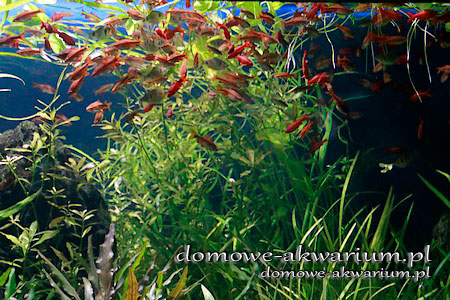
| Species | Cherry Barb |
|---|---|
| Other names | Red Cherry Barb |
| Latin Name | Puntius Titteya |
| Family | cyprinids |
| Origin | Azja Południowa |
| Length | 5 cm |
| Temperature | 22 - 27°C |
| Water Hardness | soft - medium hard |
| pH | 6.0 - 7.5 |
| Aquarium Size | 60 L |
| Food | live, frozen, dry, plant |
Cherry Barb, Red Cherry Barb, Ceylon Barb, Moss Barb
Freshwater species, endemic to Sri Lanka - basins and streams of the Kelani and Nilwala rivers. These are shallow, slow-flowing, forested sections, with clear water, shaded, with vegetation hanging from the banks, tree roots, a sandy bottom covered with litter - dry leaves and branches.
The body is elongated and colored pink-red. Along the lateral line, from the mouth to the base of the tail, runs a thin, interrupted stripe of dark brown color, and above it another - gold. Fins are pink-red. The tail fin - forked. Selectively bred color varieties are also available for sale, e.g. albino, "super" red. Males are slightly smaller, more colorful compared to females. Females are more rounded in the abdominal areas, especially during spawning.
This is a calm, curious, and active fish, which lives in groups. The company of 8-10 fish will make them less shy, males will beautifully color and compete for females' favors. This species can be kept with virtually all fish of a similar size and temperament: livebearers, loaches, catfish, corydoras, labyrinth fish, small rainbows, and other barbs, tetras, neons, rasboras, etc., shrimps. The slender barb is a species that can successfully be bred by beginner aquarists.
The aquarium should be heavily planted, with free spaces for free swimming. Decorative elements can be rocks or roots. The substrate should be fine (sand or fine gravel), preferably dark. We can lay a few dried oak or beech leaves at the bottom, which we replace every few weeks. The lighting is scattered and not very intense - floating plants or pieces of wood floating on the surface are a good solution. Remember about systematic partial water changes - about 20% every 2 weeks.

Oviparous species. It should be bred in a separate, dimly lit aquarium, with plants with small leaves, in slightly acidic water, medium hard, with a temperature from the upper range of the scale. In the evening, we introduce one or two pairs of fish (males during the spawning period are colored in an intense red color) to such a prepared tank. The fish should start spawning the next day, in the morning hours. After an intensive chase, the female lays up to 200 eggs in batches, which sink to the bottom or attach to plants. Parents do not take care of the eggs - they can even eat them. Therefore, we should catch them immediately as soon as we notice the laid eggs. The larvae hatch after 1-2 days, after another 1-2 days the fry swim freely in search of food.